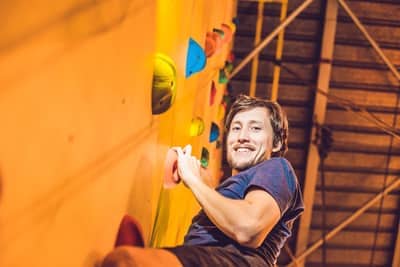Advanced climbers must put in a lot of work to make small improvements, but when new to the sport, even modest efforts pay off.
To progress as a beginner, prioritize technique training over strength training. Practice new moves and challenging problems at the start of bouldering sessions. Build good muscle memory by repeating easier problems using proper technique. Keep to a regular bouldering schedule.
How to Learn Bouldering Skills Quickly and Improve Fast
Proper technique and efficiency should be prioritized over strength training, because it is much faster to improve technique than it is to build strength (1).
New skills are easier to learn when fresh and rested, so it’s good practice to do challenging problems and new moves early in the bouldering session (1). Enhance this part of the session by being attentive of body position and centre of gravity, and by monitoring against careless footwork, an overtight grip, and mental tension, which leads to rigidity. When losing focus from fatigue, switch to easier problems.
After the first few months of bouldering, a personal coaching session will provide targeted feedback. A climbing coach can help to overcome a grade plateau, or to master techniques that are particularly challenging. The best coaches understand biomechanics, impart information with clarity, and understand the sport.
Introductory group classes jumpstart the learning process with basic but critical skills. A bouldering gym that offers classes, local competitions, and coaching will boost motivation as well as progress.
Studying advanced climbers is a great thing to do when waiting your turn at the wall. Try out their moves on a bouldering grade that is within your capabilities. Observe how they do their warmups, where they pause on the wall, how they move their feet.
Climbing guru Eric Horst recommends having a regular bouldering schedule to ensure that advancement continues (1).
Tips for Optimizing Bouldering Sessions
Before climbing, warm up to a light sweat to get good blood flow to the muscles. A warmup that gets the heart beating fast improves performance and decreases risk of injury. A few minutes with a skipping rope is one quick way to do this. Other options include warming up on an unstructured wall, or starting the session with a few easy problems.
Set a limit to how many times you will repeat a specific problem in a session, for example, only repeat a problem 3 times before moving to another. This prevents slipping into an inattentive mindset, and encourages using best effort on each try (3).
If you run into difficulties during a problem, instead of jumping off, pause for a moment to regroup (2). Take stock of hip, leg and arm positions; what could be a possible next move? Is it achievable with a shift in centre of gravity, stretching, standing on your toes, etc.? This habit will force creativity, stretch perceived limits, and extend time on the wall.
Use Repetition for Muscle Memory Success
Building good muscle memory is key to making progress (3). Muscle memory is developed by repetition, and the more repetitions, the more the memory is ingrained. Repeat a move enough and it becomes second nature. If good technique is repeated, good muscle memory results.
To ingrain good muscle memory, repeat problems within your current ability with a mindset of attaining perfect precision.
Can bad muscle memory be retrained? John Sherman, boulderer and creator of the V scale, says yes. He suffered debilitating injuries, causing imbalances that had to be reversed after he recovered from corrective surgery (3). The dysfunctional habits were corrected by repeating, over and over, the right way to move. He performed this practice during easier warmup problems, mainly at the beginning of his bouldering sessions.
Beginner Bouldering Training Tips
Avoid training when tired, because training when tired runs the risk of learning poor form and ingraining bad habits.
Redo problems until awkward, inefficient moves have been smoothed out. Redoing a problem allows you to pare it down to the best beta, eliminating wasted effort. The learned economy of motion will carry forward to future problems.
Copying the training routines of advanced climbers can lead to injury. Their muscles and tendons have had years to build up strength and resilience, and tendons in particular take at least a year to adapt to the demands of bouldering. If new to the sport, look for training routines targeted to beginners (1).
V0 to V3 problems are great for working on improving static technique, and higher grades for practicing dynamic moves.
What to Do When Progress Has Stalled
When progress has plateaued, there are several things to look at.
Improvement can be blocked if general fitness and flexibility are below average; being overweight, or weak for one’s size, can also block improvement (7). Flexibility can be addressed with stretching routines, and weakness by continuing bouldering to build up strength. Stretching routines are best done after, and not before, bouldering sessions because freshly stretched muscles are weaker.
How strong is your core? One can muscle through the first few grades, but foot technique and core strength become increasingly important at higher grades.
Multiple small technique deficiencies add up, and can prevent progression to the next V grade. Doing technique drills on an unstructured bouldering wall can reveal areas that need improvement. Explore how hip placement, hip rotation, and distance from wall impact what you can achieve.
Performance plateaus can result from bouldering too often or not often enough (7). Bouldering on most days of the week does not allow enough recovery time between sessions, but going less often than once per week probably won’t be enough to generate significant gains.
Doing too many hard problems gets in the way of mastering basic skills associated with lower V grades. Conversely, doing too many easy problems can become automatic, losing the focus and attention needed for improvement (7). Occasionally pushing yourself to 100% effort is a great boost to progress.
Tips to Improve Bouldering Performance
Using the toe of the foot allows the use of tiny holds, allows two feet to rest on one hold, and makes it much easier to twist and adjust body positioning. A habit of mainly using the middle of the foot is limiting.
Reach can be extended by bringing the hips in close to the wall, getting up on one’s toes, and straightening the back.
Working on hip and hamstring flexibility makes it possible to reach higher footholds.
When shifting to a new foothold, professional climber Paul Robinson advises to watch the foot until it is actually on the new hold (4). This fosters a feeling of secure footing and thereby increases confidence on the wall, which also boosts performance.
When both feet have to come off the wall at the same time, pull up with the arms and quickly bring knees and feet up to the next foot holds so that you are not hanging and swinging off the handholds. Pulling in and up stops uncontrolled swinging. A strong core is very helpful with this.
Fluid motion is greatly helped by studying problems before getting on. If you can get a buddy to do this for you, videos of yourself climbing will provide insights on how you are actually doing. A video of an advanced climber on the same problem provides indirect coaching, try out their sequence next time you are on that or a similar problem.
Video analysis or expert coaching at least every 6 – 12 months provides objective feedback on techniques to improve and bad habits to overcome.
When using your arms, make sure that the shoulders are also engaged. Hanging from the wall like a dead weight is bad form and hinders flow of movement.
Holding on with the right hand and the right foot, or with the left hand and the left foot, will lead to “barn dooring” away from the wall and falling off. Use opposing hand holds and foot holds for stability.
People have a tendency to do things that accent their strong skills, but it pays off to spend time mastering angles, holds, and moves that you are currently weak on. If you love static moves, practice dynos, and vice versa. The benefits will carry over to countless future problems.
Boulder with people who are more advanced, who are willing to give advice.
For more on this topic, check out my Tips for Improving Bouldering Skills article here.
Related Questions
How Long Does It Take to Move up a Bouldering Grade?
- When committed to a regular bouldering schedule of 3-4 days per week, the consensus is that V5 should be achievable within two years
- Aaron Trefler has a great article on bouldering timelines, complete with graph, on Medium (5)
- Aaron’s graph indicates that people are achieving V0 by 3 months, V1 by 6 months, V2 by a year, and V3 by a year and a half
- Going from V4 to V5, from V5 to V6, and from V6 to V7 can each take about 6 months
- Higher grades take longer to achieve: V7 to V8, and V8 to V9, can take over a year for each upgrade
- For those who can achieve this level, getting to V9 takes at least 5-6 years from scratch to attain
Addressing Excessive Fatigue
If you find that your arms get tired faster than others who are sending the
same V grades, it does not necessarily mean that they have more endurance, instead, they are probably using energy-saving techniques.
Here are some beginner tips to reduce fatigue:
- Bent arms tire fast, so when moving or pausing on the wall, relax to straight arms
- Use your larger leg muscles to advantage: Geek Climber recommends thinking of bouldering as climbing a ladder, rather than an exercise in doing pull-ups (6); let the legs take the weight
- Grasping hand holds with a death grip is exhausting; use as light a grip as the move allows
- Keep your breathing slow and even to increase confidence and reduce tension
References
- Eric J Horst, Learning to Climb Indoors. Guilford, Connecticut: FalconGuides.
- Danaan Markey: https://www.99boulders.com/bouldering-tips
- John Sherman, Better Bouldering, 3rd Edition. Guilford, Connecticut: Falcon.
- Paul Robinson: https://www.youtube.com/watch?v=nBp0HZCdo7w
- Aaron Trefler on Medium: https://medium.com/@aarontrefler/how-long-before-you-get-good-at-bouldering-6df816e3fa25
- Geek Climber: https://www.youtube.com/watch?v=M8NdZfpbj9A
- Matt Burbach, Gym Climbing: Maximizing your experience. Seattle, Washington: The Mountaineers Books

